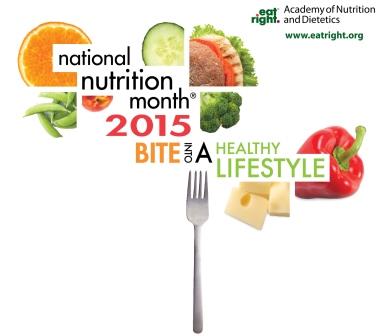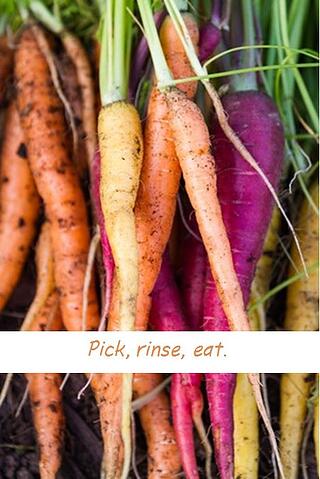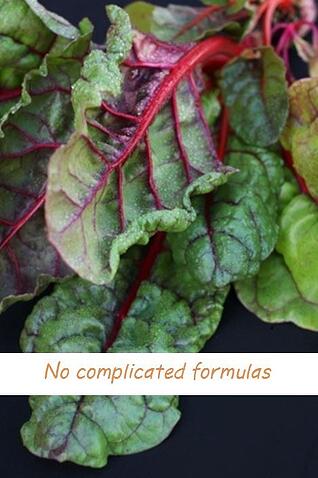 This year, good old greens are the new black. Fresh, simple eating is a fad-free way to live better and healthier. In fact, the theme of this year’s National Nutrition Month is “Bite into a Healthy Lifestyle.”
This year, good old greens are the new black. Fresh, simple eating is a fad-free way to live better and healthier. In fact, the theme of this year’s National Nutrition Month is “Bite into a Healthy Lifestyle.”
National Nutrition Month has been celebrated every March since its launch in 1973 by the world’s largest organization of Food and Nutrition professionals, now referred to as the Academy of Nutrition and Dietetics. This month was set aside to help Americans re-establish a healthy relationship with food and promote physical activity on an annual basis. Forty-two years later we still allocate this time of the year to fine tune these very important lifestyle changes.
Simple makes sense.
Although it may seem almost too simple, I love this year’s unassuming theme. To me it seems that more and more Americans are looking towards obscure remedies to cure their malaise and shed those extra pounds. Every day I hear something crazy in the news, on the internet, or being encouraged by bloggers— whether its suggesting whipping butter into your coffee to help you lose weight or eliminating certain foods simply because cavemen (with an average lifespan of ~30 years) didn’t eat them. In all reality, it isn’t that hard to eat healthy . . . you just need to go back to the basics.
 What are the basics?
What are the basics?
Start by eating fresh, whole, unprocessed and nutrient-dense foods. Once you master that, you can try fine-tuning certain aspects such as focusing on organic, avoiding genetically-engineered foods, or adding fermented foods to your diet if you desire.
What should you look for in the vegetable aisle?
When shopping for produce, don’t reach for the stars— reach for the rainbow! Choose dark green, as well as deep red and orange vegetables as these will provide you with vitamin A, vitamin C, fiber, potassium, and many other nutrients. Add some beans and peas to your shopping cart for a good source of protein, fiber, potassium, folate, iron, and essential nutrients. Skip the cookie aisle when looking to satisfy your sweet tooth and instead choose fruits.
Which sources of protein should you include in your healthy diet?
Cooking up some chicken, turkey, eggs, lean grass-fed beef, game meat or fish are all great (and delicious) ways to add some protein to your plate. To make your weekly meal plan more heart-healthy by further reducing saturated fat and cholesterol, dedicate one day of the week as a vegetarian day. Plant proteins include nuts, seeds, nut butters, tofu, tempeh, edamame, beans, soy yogurt and even quinoa. Protein is super important as it plays a key role in repairing your body from injury (including little cuts, infections, or illnesses), maintaining and growing muscle, forming enzymes necessary for processes in the body, and building new tissue.
 Where do whole grains fall into a healthy lifestyle?
Where do whole grains fall into a healthy lifestyle?
When it comes to starches, choose whole grains. Whether it is bread, oatmeal, brown rice, granola, popped amaranth or quinoa, choosing whole grains not only means you will get more vitamins, minerals, fiber, protein, and the antioxidants naturally present in the grain, but you will also see reductions in risk of diabetes, heart disease, obesity, GI disorders and certain cancers. In fact, consuming just 28 grams of whole grains daily is associated with a 5% reduction in total mortality and a pretty incredible 9% reduction in mortality from cardiovascular disease.
K.I.S.S. (Keep it simple . . . )
If you take away one thing from this, let it be that eating healthy should be simple. The key to maintaining a healthy diet will never be locked up in a mystical formula, and it shouldn’t be extremely difficult or expensive to maintain. You don’t need to buy special books, pills, shakes or appliances. Just stick with good old fashioned, unprocessed, garden fresh and homemade foods.
Celebrate National Nutrition Month by getting back to the basics. It just makes sense!
Download Great Harvest’s Guide to Whole Grains here:
If you like common-sense nutrition without the bells and whistles, check out these blogs on healthy eating:
• Mediterranean Diet Offers Easy Path to Health for Food Lovers
• Whole Grains' Health Benefits Study: Eat a Slice a Day, Live Longer!
• Juicing vs. Whole Food: the Difference is Nutrition
Image credit: National Nutrition Month campaign from the Academy of Nutrition and Dietetics.





